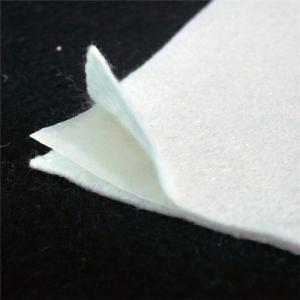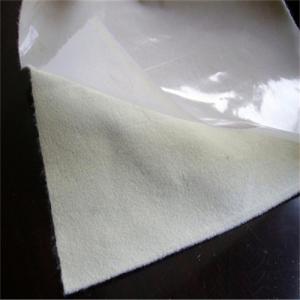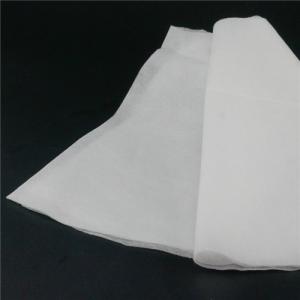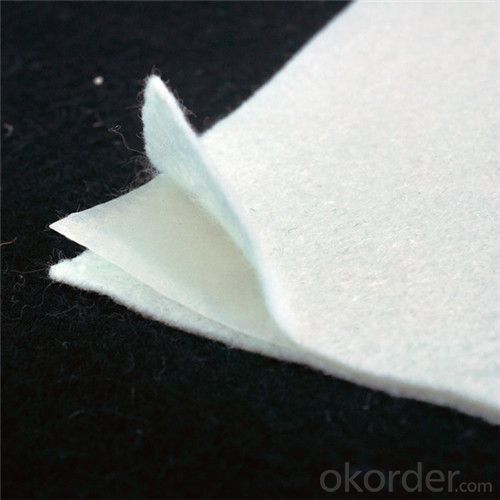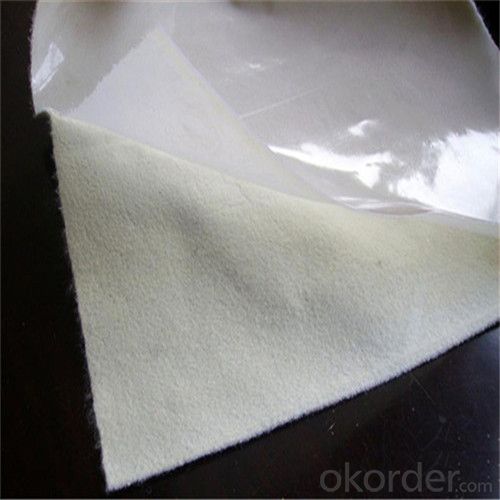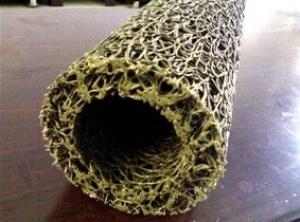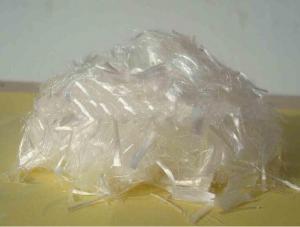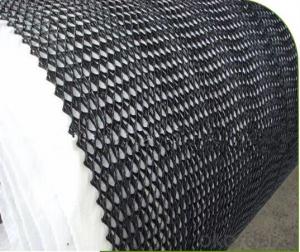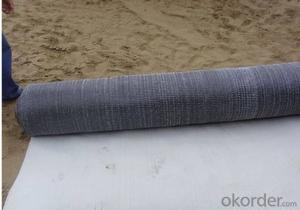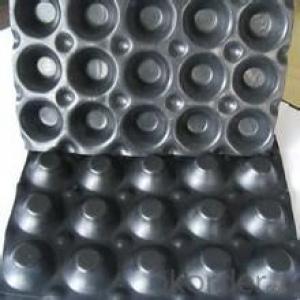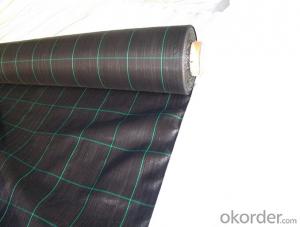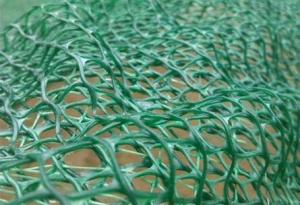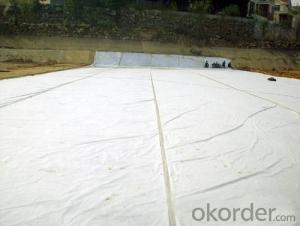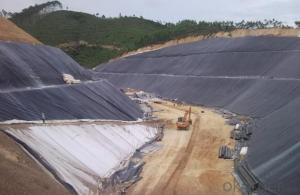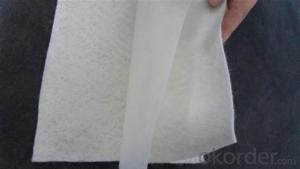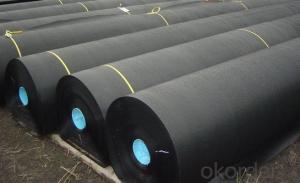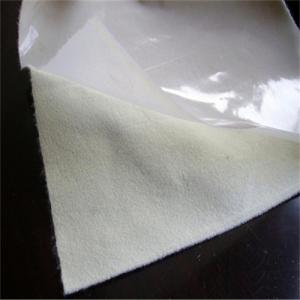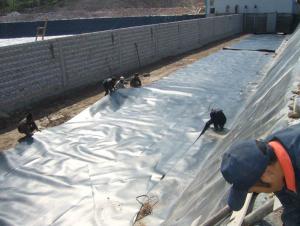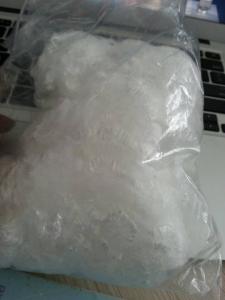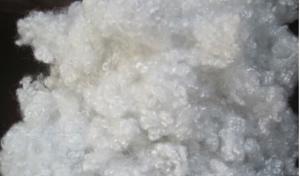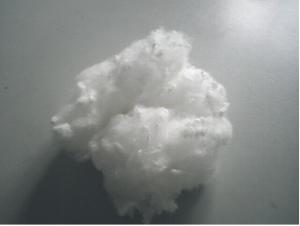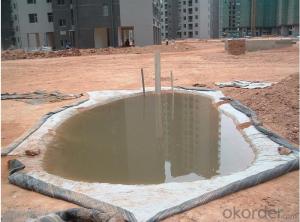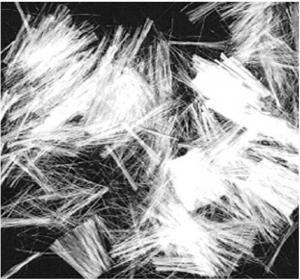Two Cloth One Film Composite Geomembrane for Water Conservancy Reservoir
- Loading Port:
- Qingdao
- Payment Terms:
- TT or LC
- Min Order Qty:
- 1000 m²
- Supply Capability:
- 100000 m²/month
OKorder Service Pledge
OKorder Financial Service
You Might Also Like
Compound Geomembrane Description:
Compound geomembrane is compounded with geotextiles and geomembrane impermeable material, it is mainly used for seepage control, composite geomembrane is divided into a cloth a film, a film and two cloth wide 4 to 6 m, weight of 200-1500 - g/m2, tensile and tearing resistance, bursting physical mechanics performance index is high, can satisfy the water conservancy, municipal, construction, transportation, subway, tunnel and other civil engineering needs. Due to the choice of the polymer material and production process to add the aging proof agent, it can be used in the abnormal temperature conditions.
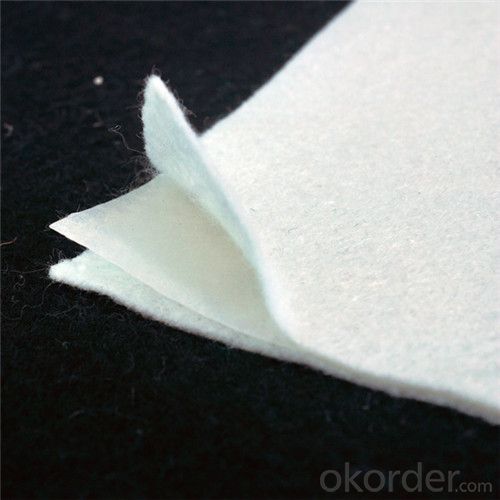
Compound Geomembrane Specification:
1)One geotextile and one geomembrane: geotextile 100-800g/m2, geomembrane 0.1- 1.0mm
2)Geomembrane with geotextile on both sides: geotextile 100-400g/m2, geomembrane 0.2-1.0mm
3)Geotextile with geomembrane on both sides: geotextile 100-800g/m2, geomembrane 0.1-0.8mm
Compound Geomembrane Property:
Good flexibility; separation, reinforcement and protection; waterproofing
Compound Geomembrane Application:
Reinforcement in channel; embankment, reservoir; waterproofing in reservoir; rock fill dam and transportation tunnel.
Compound Geomembrane Packaing
Our packing is strong enough to withstand bumping and rough handling under normal condition.
We can accept add customer's logo on the package.
Our Service
1. OEM Manufacturing welcome.
2. Free Sample to see our quality.
3. We will reply you for your inquiry in 24 hours.
4. After sending, we will track the products for you once every two days, until you get the products. When you got the goods, test them, and give me a feedback.If you have any questions about the problem, contact with us, we will offer the solve way for you.
- Q: What are the different types of geotextile fabric installation methods?
- There are several types of geotextile fabric installation methods, including trenching, overlaying, and wrapping. Trenching involves digging a trench and placing the fabric at the desired depth before backfilling. Overlaying involves placing the fabric over a prepared surface and then covering it with another layer of material. Wrapping involves encasing a structure or object with the fabric to provide protection and stability. These installation methods are used to enhance soil stabilization, erosion control, and drainage in various civil engineering and construction projects.
- Q: Can earthwork products be used in bridge abutment construction?
- Yes, earthwork products can be used in bridge abutment construction. Earthwork products such as fill materials, geotextiles, and retaining walls are commonly used to support and stabilize bridge abutments. These products help in providing a solid foundation, preventing erosion, and ensuring the stability and longevity of the abutment structure.
- Q: Are earthwork products available in various colors and finishes?
- Yes, earthwork products are available in various colors and finishes.
- Q: Can earthwork products be used in stormwater filtration systems?
- Yes, earthwork products can be used in stormwater filtration systems. These products, such as soil, sand, and gravel, are commonly used in stormwater management practices like bioretention basins, rain gardens, and infiltration trenches. They help to filter pollutants, remove sediments, and promote water infiltration, thus improving the quality of stormwater runoff.
- Q: What are the different types of geosynthetic reinforcements for bridge decks?
- There are several types of geosynthetic reinforcements that can be used for bridge decks, including geotextiles, geogrids, and geocomposites. Geotextiles are permeable fabrics that can be used to separate different layers of soil, provide filtration, and prevent soil erosion. Geogrids are typically made of high-strength polymers and are used to reinforce soil or aggregate layers, improving their load-bearing capacity. Geocomposites combine the properties of geotextiles and geogrids, providing both separation and reinforcement functions. These geosynthetic reinforcements are commonly used in bridge deck construction to enhance stability, improve durability, and reduce maintenance requirements.
- Q: What is the purpose of using geotextiles in groundwater protection projects?
- The purpose of using geotextiles in groundwater protection projects is to provide a barrier that prevents the migration of contaminants or pollutants from the surface into the groundwater. Geotextiles act as a filter, allowing water to pass through but trapping and preventing the movement of harmful substances. This helps to maintain the quality and purity of groundwater sources, ensuring their protection and preservation.
- Q: What are the advantages of using geosynthetic liners in secondary containment systems?
- Geosynthetic liners offer several advantages in secondary containment systems. Firstly, they provide a reliable barrier against leaks and spills, preventing hazardous substances from contaminating the environment. Additionally, they are highly durable and resistant to corrosion, ensuring long-term containment integrity. Geosynthetic liners are also flexible and easy to install, allowing for customization to fit various shapes and sizes of containment areas. Moreover, they are cost-effective compared to traditional options such as concrete, reducing construction and maintenance expenses. Overall, geosynthetic liners enhance the safety and effectiveness of secondary containment systems.
- Q: What are the different methods of sediment control?
- Some of the different methods of sediment control include sediment fences, sediment basins, sediment traps, erosion control blankets, silt curtains, and sediment ponds. These methods are used to prevent sediment runoff from construction sites or other areas of land disturbance, ensuring that sediment does not enter nearby water bodies and cause pollution.
- Q: What are the different types of retaining walls?
- There are several different types of retaining walls including gravity walls, cantilever walls, sheet pile walls, anchored walls, and reinforced soil walls.
- Q: How do geogrids help in railway track stabilization?
- Geogrids help in railway track stabilization by providing reinforcement and confinement to the track structure. They are placed beneath the track bed and act as a stabilizing layer, distributing the load evenly and preventing the track from shifting or deforming. Geogrids also enhance the overall strength and durability of the track, reducing maintenance needs and increasing its lifespan.
Send your message to us
Two Cloth One Film Composite Geomembrane for Water Conservancy Reservoir
- Loading Port:
- Qingdao
- Payment Terms:
- TT or LC
- Min Order Qty:
- 1000 m²
- Supply Capability:
- 100000 m²/month
OKorder Service Pledge
OKorder Financial Service
Similar products
Hot products
Hot Searches
Related keywords
